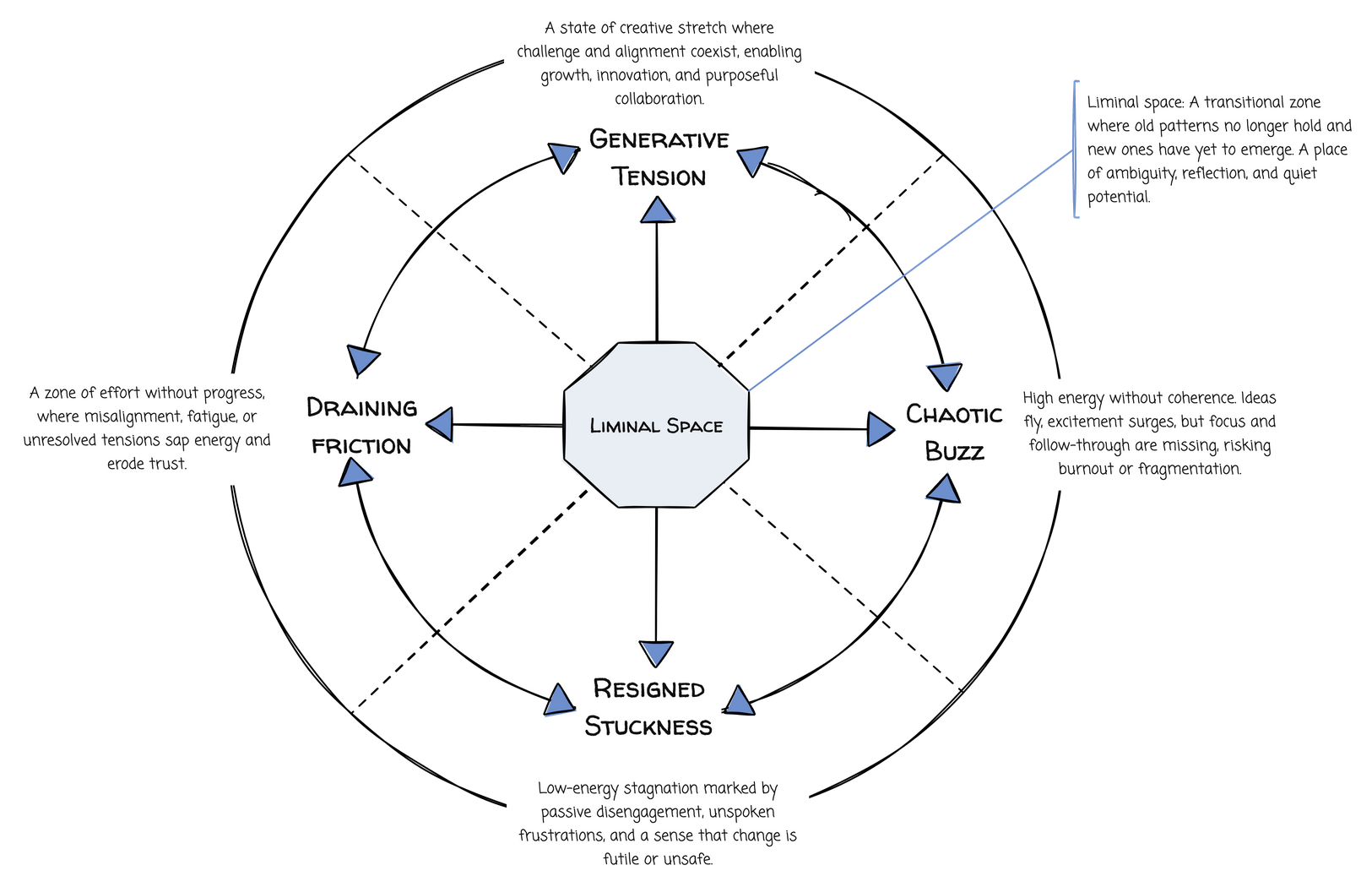Coherence Mapping
If teams use a shared visual map to locate tensions in relation to their energy and emotional tone, and they revisit and reflect on those tensions regularly, then they tend to deepen their learning, notice shifts, and act with more coherence.
When teams surface tensions, they often lose track of them, forgetting what sparked energy or confusion in the first place. Without a shared way to hold, revisit, and make sense of tensions over time, learning fragments and action becomes reactive. Coherence Mapping offers a durable artefact that allows teams to place, reflect on, and adapt tensions as part of an ongoing inquiry.
How to use this pattern
Coherence Mapping is used in three recurring ways:
Placement
Tensions are named and placed in one of five zones based on their current energy or experiential feel:
Generative Tension – creative stretch, energising
Chaotic Buzz – noise, scatter, overstimulation
Draining Friction – slow erosion, repetitive strain
Resigned Stuckness – inertia, helplessness
Liminal Space – uncertain, emerging, transitional
Discussion
Facilitated dialogue explores what each placement reveals. Teams ask:
Why does this tension sit here?
What’s keeping it in this zone?
What would it take for it to move?
Or is it okay where it is for now?
Reflection and Adaptation
Over time, tensions are:
Remixed – merged with others or reframed
Withdrawn – if no longer relevant or active
Adapted – moved across zones to reflect current dynamics
This makes the map a living artefact of ongoing learning.
Affordances
Named zones offer intuitive anchors for emotional tone and group energy
Acts as memory across sessions, surfacing shifts that might otherwise go unnoticed
May be misused as a diagnostic or maturity model.
Stances
Inquirer. This stance drives the initial framing of the mapping exercise, posing questions like "what are we trying to make sense of?" or "where do we need more clarity?" It ensures the mapping begins with genuine curiosity about the current state of understanding.
Challenger. This stance is crucial during the mapping process, encouraging participants to question implied connections or expose contradictions between different elements on the map. It prevents false coherence from being created prematurely.
Synthesiser. This stance is at the heart of Coherence Mapping, as it focuses on identifying patterns, relationships, and emergent themes across the disparate pieces of information being mapped. It helps to weave together diverse perspectives into a shared, albeit provisional, understanding.
Noticer. This stance is vital for observing the subtle emotional and relational dynamics within the group as the map is being built. It helps to sense unspoken tensions or shifts in understanding that might not be explicitly articulated on the map.
Facilitator. This stance actively guides the group through the mapping process, setting clear boundaries, managing the visual representation, and ensuring equitable participation so that all perspectives are surfaced and considered.
Steward. This stance holds the intention for the map's long term usefulness, ensuring that the insights gained contribute to an evolving sense of shared purpose and continuity for the community's work.
Shaper. While Coherence Mapping is primarily a sensemaking activity, this stance comes into play if the map reveals an opportunity to design a small, targeted probe or intervention to test a newly perceived connection or address a specific tension.
Craftsperson. This stance ensures that the coherence map is created with care and clarity, making it an accessible and usable artefact for the community. It also applies to the integrity with which insights from the map are shared and acted upon.

